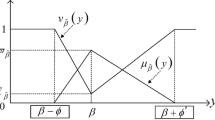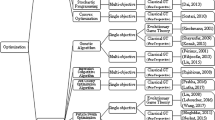Abstract
This paper extends the potential function and consistency to the Owen value for fuzzy cooperative games with a coalition structure. First, we prove that the unique payoff index satisfying the potential function is the Owen value. Then, we characterize the Owen value for fuzzy cooperative games with a coalition structure by fuzzy balanced contributions and fuzzy consistency, respectively. Finally, an example in supply chain is given to illustrate the relationship between the Owen value and potential function for fuzzy cooperative games with a coalition structure and solve the problem of payoff distribution in supply chain under fuzzy environment.





Similar content being viewed by others
Notes
Tsurumi et al. (2001) defined fuzzy games with Choquet integral form, the value of fuzzy coalition for fuzzy games with Choquet integral form is given as \(v_{C} (U) = \sum\limits_{l = 1}^{q(U)} {v_{0} ([U]_{{h_{l} }} )(h_{l} - h_{l - 1} )}\), for any \(U \in L(N)\), where \(Q(U) = \{ \left. {U(i)} \right|U(i) > 0,i \in N\}\) and \([U]_{{h_{l} }} = \{ \left. {i \in {\text{Supp}} U} \right|U(i) \ge h_{l} \}\). \(q(U)\) is the cardinality of \(Q(U)\). The elements in \(Q(U)\) are written in the increasing order as \(0 = h_{0} \le h_{1} \le \ldots \le h_{q(U)}\). Later, Meng et al. (2012) gave the definition of the Owen value for fuzzy cooperative games with a coalition structure and Choquet integral form.
References
Aubin, J. P. (1974). Coeuret valeur des jeux flous à paiements latéraux. Comptes Rendus Hebdomadaires D, 279, 891–894.
Aumann, R. J., & Dreze, J. H. (1974). Cooperative games with coalition structures. International Journal of Game Theory, 3(4), 217–237.
Butnariu, D. (1980). Stability and Shapley value for an n-persons fuzzy game. Fuzzy Sets and Systems, 4(1), 63–72.
Butnariu, D., & Kroupa, T. (2008). Shapley mappings and the cumulative value for n-person games with fuzzy coalitions. European Journal of Operational Research, 186(1), 288–299.
Dragan, I. (1996). New mathematical properties of the Banzhaf value. European Journal of Operational Research, 95(2), 451–463.
Hart, S., & Mas-colell, A. (1989). Potential, value and consistency. Econometrica, 3, 589–614.
Hu, X. F. (2021). New axiomatizations of the Owen value. Mathematical Methods of Operations Research, 93(3), 585–603.
Huang, W., & Swaminathan, J. M. (2009). Introduction of a second channel: Implications for pricing and profits. European Journal of Operational Research, 194(1), 258–279.
Liang, P., Hu, J., Li, B., Liu, Y., & Chen, X. (2020). A group decision making with probability linguistic preference relations based on nonlinear optimization model and fuzzy cooperative games. Fuzzy Optimization and Decision Making, 19(4), 499–528.
Lorenzo-Freire, S. (2016). On new characterizations of the Owen value. Operations Research Letters, 44(4), 491–494.
Meng, F. Y., & Zhang, Q. (2010). The Shapley function for fuzzy cooperative games with multilinear extension form. Applied Mathematics Letters, 23(5), 644–650.
Meng, F. Y., Zhang, Q., & Cheng, X. H. (2012). The Owen value for fuzzy games with a coalition structure. International Journal of Fuzzy Systems, 14(1), 22–34.
Myerson, R. B. (1980). Conference structures and fair allocation rules. International Journal of Game Theory, 9(3), 169–182.
Owen, G. (1971). Multilinear extensions of games. Management Science, 18(5), 64–79.
Owen, G. (1977). Values of games with a priori unions. In R. Henn & O. Moeschlin (Eds.), Mathematical economics and game theory (pp. 76–88). Springer.
Peleg, B. (1986). On the reduced game property and its Converse. International Journal of Game Theory, 15(3), 187–200.
Sakawa, M., & Nishizaki, I. (1994). A lexicographical solution concept in an n-person cooperative fuzzy game. Fuzzy Sets and Systems, 61(3), 265–275.
Taleizadeh, A. A., Akhavizadegan, F., & Ansarifar, J. (2017). Pricing and quality level decisions of substitutable products in online and traditional selling channels: Game–theoretical approaches. International Transactions in Operational Research, 26(5), 1718–1751.
Tijs, S., Branzei, R., Ishihara, S. I., & Muto, S. (2004). On cores and stable sets for fuzzy games. Fuzzy Sets and Systems, 146(2), 285–296.
Tsurumi, M., Tanino, T., & Inuiguchi, M. (2001). A Shapley function on a class of cooperative fuzzy games. European Journal of Operational Research, 129(3), 596–618.
Winter, E. (1992). The consistency and potential for values of games with coalition structure. Games and Economic Behavior, 4(1), 132–144.
Xu, G. J., Dai, H., Hou, D. S., & Sun, H. (2016). A-potential function and a non-cooperative foundation for the Solidarity value. Operations Research Letters, 44(1), 86–91.
Yu, X. H., Du, Z. P., Zhang, Q., Zou, Z. X., Zhou, Z., & Pang, J. H. (2020). Generalized form solutions of cooperative game with fuzzy coalition structure. Soft Computing, 24(2), 861–877.
Zhang, Y., Gao, J., Li, X., & Yang, X. (2021). Two-person cooperative uncertain differential game with transferable payoffs. Fuzzy Optimization and Decision Making, 20(4), 567–594.
Zou, R., Xu, G. J., Li, W., & Hu, X. F. (2020). A coalitional compromised solution for cooperative games. Social Choice and Welfare, 55(4), 735–758.
Acknowledgements
This work was supported by the Major Project for National Natural Science Foundation of China (No. 72091515), the Fundamental Research Funds for the Central Universities of Central South University (No. 2022ZZTS0344), the Natural Science Foundation of Changsha in China (No. kq2202112), and the Startup Foundation for Introducing Talent of NUIST (No. 2022r059).
Author information
Authors and Affiliations
Corresponding author
Additional information
Publisher's Note
Springer Nature remains neutral with regard to jurisdictional claims in published maps and institutional affiliations.
Rights and permissions
Springer Nature or its licensor holds exclusive rights to this article under a publishing agreement with the author(s) or other rightsholder(s); author self-archiving of the accepted manuscript version of this article is solely governed by the terms of such publishing agreement and applicable law.
About this article
Cite this article
Li, Z., Meng, F. The potential and consistency of the Owen value for fuzzy cooperative games with a coalition structure. Fuzzy Optim Decis Making 22, 387–414 (2023). https://doi.org/10.1007/s10700-022-09397-w
Accepted:
Published:
Issue Date:
DOI: https://doi.org/10.1007/s10700-022-09397-w




